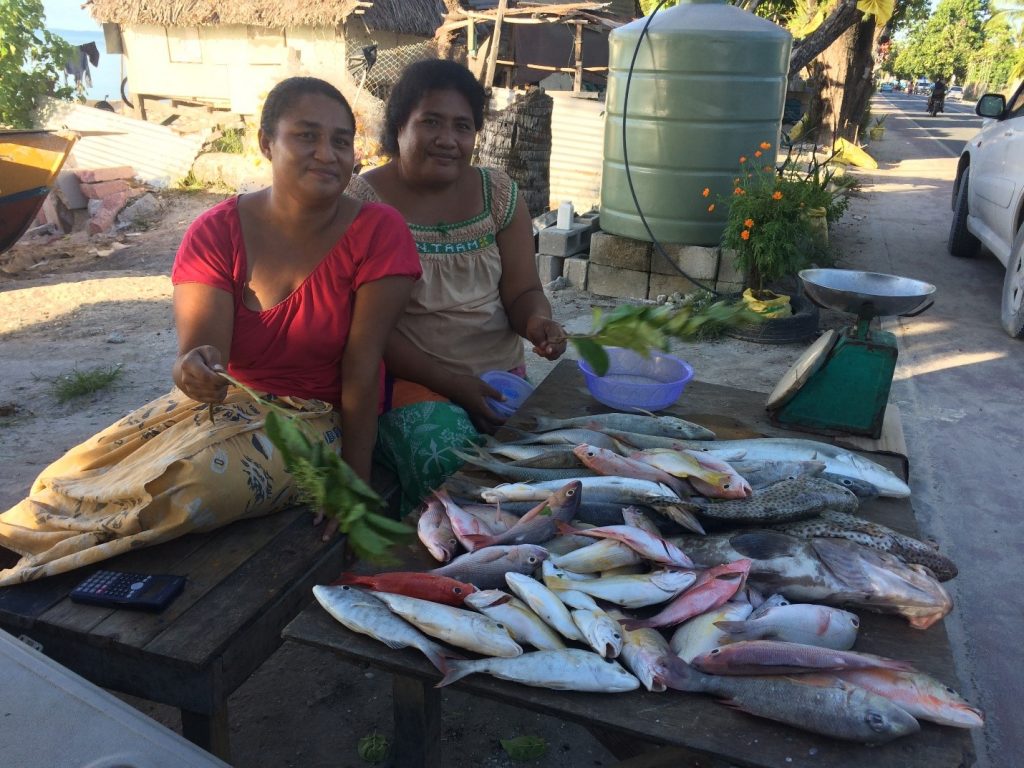
See also: NAP Global Network report on Strengthening Gender Considerations in Kiribati’s NAP Process.
Kiribati—a country made of 33 low-lying atolls scattered across the Pacific Ocean—is already experiencing an increase in sea-surface temperatures and sea-level rise. Adding to these risks is Kiribati’s extreme remoteness, with hundreds of kilometres of ocean between the atolls and their closest Pacific neighbours like Samoa and Tuvalu.
Sea-level rise is a major concern considering that all of Kiribati’s atolls (except for one, Banaba Island) are no more than three metres above sea level, and the majority of people and infrastructure are located on the coast with limited options for relocation.
Climate change is further exacerbating existing development challenges, particularly in relation to access to freshwater resources and arable land for agriculture.
Gender inclusion in Kiribati
To address these issues, the country has developed a national adaptation plan (NAP) document: the Joint Implementation Plan on Climate Change and Disaster Risk Management (KJIP) in 2014. The Government of Kiribati has identified gender inclusion as a key principle that should be integrated into all strategies and actions of the plan. One of the 12 strategies prioritized in the KJIP also explicitly targets vulnerable groups, with a focus on equal participation and training of women.
The country aims to revise its KJIP in 2017/18 to align it with the new government’s priorities. To explore options for strengthening gender considerations in the revision of the KJIP, the NAP Global Network collaborated with the Office of the President to hold stakeholder consultations in the capital, South Tarawa, in August 2017.
Linking gender equality and climate change adaptation
We found that the integration of gender considerations in the KJIP is a major positive change because the linking of climate adaptation to gender equality is new at the policy and project levels. Gender equality has only been recently raised as a political issue and gender mainstreaming has mostly occurred in relation to domestic violence.
But much more needs to be done to foster better understanding of the linkages between gender equality and climate adaptation among government officials and women’s organizations.
We would recommend the following steps to strengthen gender considerations in the revision of the KJIP:
- Frame the gender equality issue in line with the I-Kiribati culture–with an emphasis on building a climate-resilient family. Many of the consultation participants perceived that the root causes and challenges related to gender equality are located in the family unit. A family-focused approach to gender equality recognizes that women and men are part of a complex web of institutions (e.g., educational, political and religious) among which the family continues to play a very central role in I-Kiribati society. Building a family’s resilience to the negative impacts of climate change involves an awareness of the different roles (and related vulnerabilities) of women and men in the family and their different climate adaptation needs and capacities.
- Strengthen the linkages between women’s economic empowerment and climate adaptation. The broadening of the gender equality goals beyond ending violence against women to also focus on guaranteeing the integration of women in economic and development processes provides a good entry point to strengthen the integration of gender issues in the KJIP and to position women as agents of change. It provides an opportunity to explore equitable access to, and control over, assets and services between women and men—including the impacts that climate hazards have on the capacities of women and men to access and benefit from these resources. Understanding these impacts will help with determining appropriate adaptation needs and capacities between women and men.
- Conduct an analysis of the impacts of climate hazards on women and men in different contexts (e.g., urban versus rural) to provide a more detailed analysis of gender issues in the context of climate variability and change. This analysis can serve to support gender mainstreaming by: broadening the understanding of gender issues (i.e., beyond gender-based violence and women’s participation); deepening the understanding of gender issues (i.e., understanding which men and women are most vulnerable to climate change, how they are vulnerable, why and how this changes over time); and creating an evidence base and a baseline.
- Engage the women’s ministry, civil society organizations working on women empowerment and gender experts to inform the KJIP review and the NAP process more broadly. It is crucial to reinforce the role and relevance of the Ministry of Women in the NAP process. A network of civil society organizations working on women empowerment at the community level also exists and could contribute to support the integration of women’s views and perspectives in the KJIP process. Capacity building of these actors on climate adaptation is needed so they are empowered and can contribute to the NAP process.
Going forward, the NAP Global Network will work with the Office of the President and the Ministry of Women, Youth and Social Affairs to explore how to take actions based on these recommendations as part of the revision of the KJIP.
Any opinions stated in this blog post are those of the author and do not necessarily reflect the policies or opinions of the NAP Global Network, its funders or Network participants.
Read more about gender-responsive NAP processes.
Interested in joining the Network as a participant? Find out more.